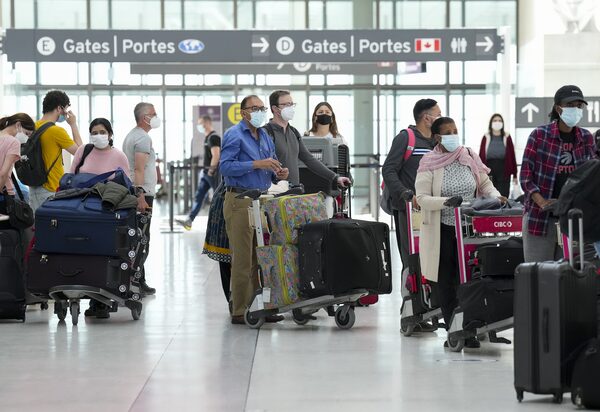
People wait in line to check in at Pearson International Airport in Toronto on May 12.Nathan Denette/The Canadian Press
If you think the wait to board a plane is excruciating, or that an airport with long wait times is hell on Earth, perhaps you should consider how long Canadians routinely wait for essential medical care, or what it’s like for someone to spend 24, 48 or 72 hours on a gurney in a hospital hallway.
Getting cancer treatments, hip transplants and mental-health care in a timely fashion seems infinitely more important than getting to a business meeting or holiday destination. Yet, you wouldn’t know it from the political and media reaction.
Retired hockey player and now podcaster Ryan Whitney got wall-to-wall media coverage when he posted a video of his 24-hour airport horror story on Twitter last week, declaring Toronto’s Pearson International Airport was “the worst place on Earth.”
Anyone who has been to a hospital emergency room would likely take umbrage with that claim.
The median wait time in ERs in Canada is “only” 3.2 hours, but that’s just for an initial assessment. If you need any follow-up, like an X-ray or, god forbid, hospital admission, that number balloons.
For example, 10 per cent of seniors who need to be admitted to hospital from the ER wait more than 37.8 hours on a gurney. That’s a day-and-a-half lying a hallway in a flimsy hospital gown, probably using a bedpan and, by the way, being so sick that you should be in a hospital room.
On Friday, four federal ministers – transport, health, public safety and tourism – issued a statement vowing to reduce airport wait times. Governments acting to resolve problems is a good thing. Canadians shouldn’t be waiting hours to get to airport gates, or lining up for days to get passports.
But surely some queues merit a little more attention than others? Wouldn’t it be nice to see the ministers of the crown snapping to attention to address the waits suffered by patients needing ER care, surgeries, or mental-health care?
The word “privilege” springs to mind. The vast majority of those mired in health care queues are elders; they don’t wear fancy suits and post outraged rants to Twitter. They suffer in silence.
A few weeks ago, the Canadian Institute for Health Information released its latest data on surgical wait times (which have festered for decades) including a look at the impact of COVID-19. We learned 600,000 fewer surgeries were performed in the first 22 months of the pandemic compared to a similar period pre-pandemic.
CIHI data show that, for the first months of the pandemic, 51 per cent of patients waiting for joint replacements (mostly hips and knees) were treated during the recommended time frame of 182 days. Pre-pandemic, performance wasn’t great either, at 71 per cent.
Similarly, for cataracts, only 45 per cent of patients got the surgery with the recommended 112 days early in the pandemic. Pre-pandemic, it was 69 per cent, nothing to brag about.
And, if we want to use anecdote – the way we do when reporting on airport waits – people are now being told the wait for new joints will be about two or three years. That’s years of living in pain – not just a few hours in an Air Canada baggage drop-off line.
To its credit, the federal government has committed $2-billion to help clear up the backlog of surgeries. But that will take time: According to an estimate by the Ontario Medical Association, it will take 30 months to catch up on knee replacements, 25 months for cataracts, 19 for hips, 14 for heart bypass surgery, and 11 months for diagnostic tests like MRIs.
Like airport wait times, hospital wait times have multiple contributing factors and one seemingly small problem can lead to a devastating domino effect.
A shortage of baggage handlers can lead to a plane waiting on the runway for hours which, in turn, means airline crews are working excess hours, and their subsequent flights get delayed or cancelled. Similarly, in hospitals, the backlog that leads to people spending days on gurneys in hallways is owing to lack of beds on the ward which, in turn, is owing to an inability to move stable patients to nursing homes.
Simple gestures can’t resolve multi-faceted problems, and pointing fingers doesn’t help. What is certain though is that the airport queues will be a lot easier to clear up than the hospital ones.
That’s all the more reason we should be focusing a lot more of our attention – political, media and public – on Canada’s health care failings than on our travel woes.
Keep your Opinions sharp and informed. Get the Opinion newsletter. Sign up today.
 André Picard
André Picard